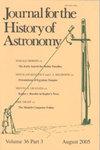近代早期欧洲的新恒星,旧宇宙论
IF 0.3
3区 哲学
Q3 HISTORY & PHILOSOPHY OF SCIENCE
引用次数: 0
摘要
1572年的“新星”和后来的1577年的彗星破坏了关于天堂的永恒性和天体的坚固性的霸权观念,并标志着亚里士多德-托勒密世界观解体的关键时刻。这些戏剧性的事件与第谷·布拉赫的杰出人物有关,在学术文献中得到了广泛讨论,并在有关科学革命的一般调查和教科书中得到了应有的地位。1570年代的英雄事件盖过了不到30年后出现的另一颗“新星”,因此在科学史上被忽视了。本文正在审查中,这本散文集是帕特里克·博纳和其他几位科学历史学家正在进行的史学工作的成果,目的是修改这幅图,并强调1604年“新星”出现的争议的重要性,特别是开普勒关于这一天体事件的论文的重要性。第谷·布拉赫和迈克尔·梅斯林在北欧上空观测到明亮的新光后的三十年,给了数学家、观星者和自然哲学家很多时间来评估布拉赫的激进结论。1604年另一颗“新星”的出现提供了一个合适的机会来回顾新的天空观的含义。在这个新天体出现后的讨论和争议中,开普勒突出地理解了天堂里的新奇事物需要新的知识模式。这是一个重新划定公认的天文学调查和迷信推测之间界限的机会。此外,它为他提供了一个幸运的机会,在数学和哲学的基础上推动日心说事业。关于一个新天体的出现,开普勒面临的主要困难是,他认为生成和衰变的相同原理统治着月球上方的领域,就像它们统治着月球下方的世界一样,这与他对世界无限性的信念相冲突。如果恒星出生和死亡,那么人们可以假设有多个世界;根据伊壁鸠鲁和佐丹诺·布鲁诺的激进宇宙学,这样的多元性需要一个无限且同质的空间来容纳它。开普勒憎恶无限宇宙的概念,这破坏了他对一个秩序井然的世界的信念,这个世界有一个可识别的中心来决定距离和方向的问题。1193712 JHA0001.1177/0218286231193712天文学史杂志书评2023本文章由计算机程序翻译,如有差异,请以英文原文为准。
New stars, old cosmologies in early modern Europe
The “New Star” of 1572 and later the comet of 1577 undermined the hegemonic notions concerning the immutability of the heavens and of the solidity of the celestial orbs and signaled a critical moment in the dissolution of the Aristotelian-Ptolemaic worldview. These dramatic events, associated with the herculean figure of Tycho Brahe, were extensively discussed in scholarly literature and received their due place in general surveys and textbooks concerned with the Scientific Revolution. The heroic episode of the 1570s overshadowed another “New Star” that appeared less than 30 years later and was thus much disregarded in the history of science. The collection of essays, here under review, is the culmination of an ongoing historiographical effort by Patrick Boner and several other historians of science to amend this picture and underscore the significance of the controversy over the appearance of a “New Star” in 1604, and especially the importance of Kepler’s treatise concerning this celestial event. The three decades that had elapsed since Tycho Brahe and Michael Maestlin observed the bright new light in the sky over northern Europe gave much time for mathematicians, star-gazers, and natural philosophers to assess the radical conclusions of Brahe. The appearance of another “New Star” in 1604 provided a suitable opportunity to review the implications of the new view of the heavens as mutable. In the discussions and controversies that followed the appearance of this new celestial body, Kepler stood out in understanding that novelties in heaven demand new modes of knowledge. It was an occasion to redraw the demarcating lines separating well-established astronomical inquiries and superstitious speculations. Further, it provided him with a fortunate opportunity to promote the heliocentric cause on both mathematical and philosophical grounds. The main difficulty Kepler faced regarding the appearance of a new celestial body was the clash between his belief that the same principles of generation and decay govern the realm above the moon just as they govern the world below it and the notion associated with this belief in the infinity of the world. If stars are born and die, then one may assume a plurality of worlds; according to the radical cosmologies of Epicurus and Giordano Bruno, such a plurality requires an infinite and homogenous space to contain it. Kepler abhorred the notion of an infinite universe that undermined his conviction in a well-ordered world with an identifiable center to determine questions of distance and direction. 1193712 JHA0010.1177/00218286231193712Journal for the History of AstronomyBook Reviews book-review2023
求助全文
通过发布文献求助,成功后即可免费获取论文全文。
去求助
来源期刊

Journal for the History of Astronomy
地学天文-科学史与科学哲学
CiteScore
0.50
自引率
25.00%
发文量
44
审稿时长
>12 weeks
期刊介绍:
Science History Publications Ltd is an academic publishing company established in 1971 and based in Cambridge, England. We specialize in journals in history of science and in particular history of astronomy.
 求助内容:
求助内容: 应助结果提醒方式:
应助结果提醒方式:


